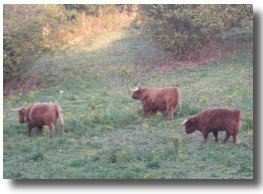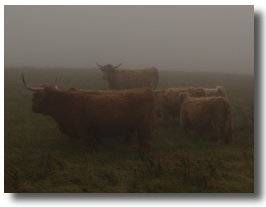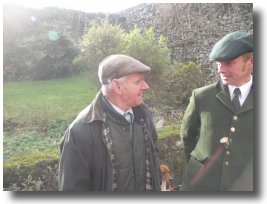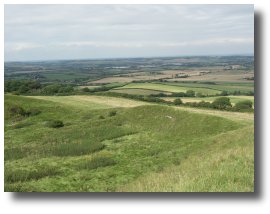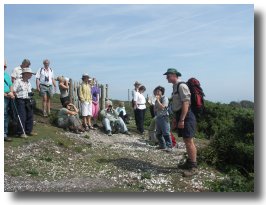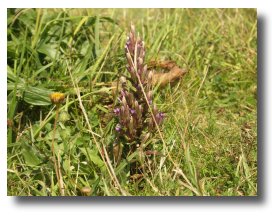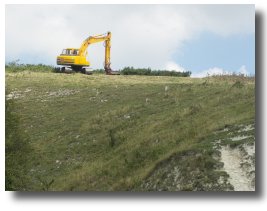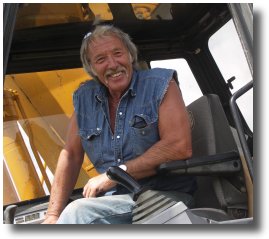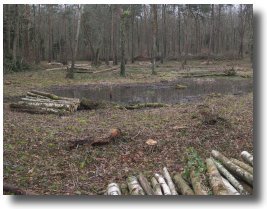Cattle
The month's main event was the dispatch of nearly 30-month old Angus cross Highland heifers to Frome market. Barry had it all carefully planned and his stock was in excellent condition.
The 11 heifers we did take looked strangely out of place at Frome. Although well presented by Barry, they looked naturally small against the larger beasts and their longer coats showed up the wear of travel. Averaging about 450 kg, they made between 75p and 80p per kilo. More than the auctioneer's estimate, but still much less than they would have fetched many yeas ago. It was an active market day, but it was soon apparent that the buyers were interested only in commercial cattle of a certain type. Our niche animals, although of excellent potential quality beef, could never figure in their plans. Sending them direct to abattoirs is also unsatisfactory because they, too, are not geared to accept specialist beef. This year we had nearly 50 pedigree Highland calves, evenly split between males and females. The better quality females will be used to add to our own breeding stock. The others will have to be sold for pedigree, conservation grazing, or beef. It is going to take a lot of thought and effort to open up the three separate markets. The steers will be sold to specialist Highland finishers when they are about 18 months old. How do we get a proper, even break even, reward for producing such lovely cattle, of good conformation, fit and healthy, and from a breed which makes the finest beef in the UK? We were pleased to welcome Alistair Harrison, a fellow Highland cattle enthusiast from East Grinstead, to see our stock. He was interested in buying an old bull. The superb Rory, the Champion Male at the Royal Highland Show in 1999, would have been ideal for his needs but he is not for sale! He is nevertheless a useful friend to have made. Mid September I went to the annual Newbury Show, my first visit. It is a fantastic two-day agricultural show attended by tens of thousands of people. The organizers and exhibitors do a splendid job. I went to see the Highland cattle. I was amazed at the exhibitors' dedication. They prepare their show cattle beautifully and spend two days on the show ground with them. For me, the day's highlight was the parade of cattle in the main show ring. In addition to all the cattle movements and our visitor, the routine seasonal work had to carry on. All the cattle were seen for checking their feet and trimming their hooves. Ear tags were checked and cattle re-tagged where necessary.
| |||||||||||||||
|
|
At Countryside Stewardships' suggestion, we planted some yellow rattle over 2 hectare on Wroxall Down. This is a yellow chalk grassland flower which breaks up sword which is too tightly knotted. It is a valuable conservation tool. We selected and prepared two 1 hectare plots, and planted l0 kg in one and 5kg in the other. Next summer we will be able to assess the results. In many ways I regretted it. Not only the price - £1,500 plus VAT for a 15kg sack, but more importantly because it was the first time I have imported seed. I much prefer natural regeneration.
During the month the hedges had to be trimmed. This has been done on an alternative year basis but in future they are going to be trimmed twice in every five years. This is to improve their quality as habitats for many forms of wildlife, especially birds.
Last autumn contractors made a mess of sowing previously arable fields with grass seed. They left the ground dangerous for cattle, horses or people to walk over. The worst patches had to be evened out by discing and then re-sewn. It is a great improvement but the new grass is yet to emerge.
|
|
Walks
On 3rd September, the National Trust and ourselves co-hosted a walk over some of our respective but adjoining properties, meeting at Wroxall Cross Farmhouse. The National Trust is an ideal neighbour. We share so many of the same aims and we each benefit by the other not using fertilizers or pesticides. This is of immense value to the wild life, both flora and fauna, for which both our sites are so noted. The first part of the walk was spent on Wroxall Cross Farm, going through Wroxall Copse and on to the National Trust Ventnor and Luccombe Downs. The National Trust is doing a fine job and deserves every congratulation.
|
|
The walk then ended back on our own farm, having crossed South Down. South Down and St Martin's Down were a joy to behold in the late summer. Both downs were still ablaze with wild flowers which attracted a whole variety of butterflies. This year was exceptional for Autumn Gentian. There were literally thousands of them.
Birds
During the year two bird surveys have been carried out. The RSPB organised a volunteer survey at Wroxall and Graham Sparshott undertook a more thorough survey at Idlecombe and Rowborough with two visits a month between April and October. His final report will be out in November, but in September he recorded two Turtle Doves and peak counts of three Tree Pipits, six Spotted Flycatchers and eleven Common Redstarts. Also, a Little Owl was new for the recording area. Although there are only 7,000 to 14,000 pairs in the country, we have them at Wroxall, and on the mainland this summer one flew down our chimney two days running!
We have wonderful bird populations on West Wight and in our woodlands at Havenstreet, but for various reasons it is not so good at Wroxall. There are so many predators, especially the corvids and raptors, and the large populations of both foxes and badgers disturb the ground nesting birds. Next year I hope to manage our grass better and start improving our hedges to enhance the habitats.
Foxhunting
Since this is a fox hunting estate, it is now strangely quiet following its abolition. People are miserable about it, especially those who work on the farm for whom hunting was their main recreation.
What are we going to do? The fox population will increase, thus endangering further all our ground nesting birds. Snaring is diabolically cruel; shooting with shotguns causes high wounding rates; poisoning is illegal and gassing nearly so. If properly carried out, lamping with rifles at night is relatively humane but with our public access and livestock around the farm, it is too dangerous to consider. Trapping is only efficient with urban foxes. Those ignorant and prejudiced MP's at Westminster will have much to answer for when they face their Day of Judgment!
|
|
Downland Management
On West Wight, Barry King completed a busy six weeks of "shaving" the summer scrub and bramble growth off the chalk grassland restoration areas. It is a time consuming and dangerous job but worth it and satisfying. The downs now look beautiful and the work will help the grass to re-establish itself more and thus provide better grazing for the cattle next summer.
When working on Idlecombe Down, 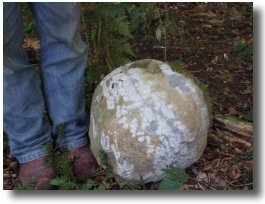 Barry moved a large spherical stone, about 15" in diameter. It seems too big to be a natural phenomenon. I am sending photos to the IW Archaeological Department of the IW Council.
Barry moved a large spherical stone, about 15" in diameter. It seems too big to be a natural phenomenon. I am sending photos to the IW Archaeological Department of the IW Council.
On Mottistone Down, Barry has coppiced much of the old leggy gorse.
In time it will re-generate and provide wonderful habitat for a whole range of mammals, birds (including the Dartford Warbler) and invertebrates.
|
|
On Mottistone Common, Barry started his annual work restoring heathland. This year we are concentrating on eradicating 100% of the Holm Oak and 95% of the Rhododendrons. It is, however, one of the most important sites on the Island for the ground nesting Nightjar, a scarce and declining summer visitor. The heather is coming back quite beautifully.
Mottistone Common is now open to public access under the CRoW Act. To try and manage the paths so as to discourage people leaving from them and disturbing the wildlife,
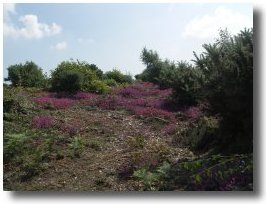 we made a special path to give them a circular walking route but it was totally unused in the summer months. It became overgrown and Barry has cleared it out again.
we made a special path to give them a circular walking route but it was totally unused in the summer months. It became overgrown and Barry has cleared it out again.
Woodlands
During the month we got the digger to clear the ditches feeding our two man-made ponds.
At Coombe Plantation, the ditches and springs feed the pond which acts as a reservoir and which, in turn, feeds the drinking troughs for the cattle on Mottistone Down.
There have been no major works in the woodland this month. Bob Wright, however, has mown all the rides in Rowlands Wood and Chillingwood, removing their summer growth and thus preparing them for the winter and next spring.
I looked at the pond in South Rowlands. This woodland pond was cleared out earlier this year and at the time it looked very successful. Either because we let in too much light, or the dry winter failed to replenish the water, the pond dried up and all our work became covered in high vegetative growth and saplings. I do not yet know how we are to solve this problem!
|
|
|
